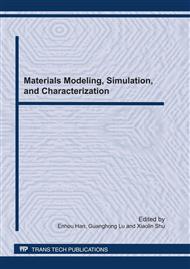p.1
p.11
p.16
p.24
p.29
p.33
p.39
p.43
3D Numerical Simulation of Flow and Temperature Field in Semi-Solid Slurry Preparation by A-EMS
Abstract:
Annular electromagnetic stirring (A-EMS) process is an advanced semi-solid metal processing technology. It could avoid the effect of skin effect, increase the shear rate, reduce the temperature gradient and refine microstructures. A three-dimensional computational model sequentially coupling electromagnetic stirring with a macroscopic heat and fluid flow in A357 alloy semisolid slurry preparation by A-EMS has been developed. Comparison between microstructures of A357 alloy produced by EMS and A-EMS has been made. The results show that the annulus gap avoids the part of low magnetic induction intensity and A-EMS avoids the effect of skin effect. The annulus gap prohibits the circular flow and increases the shear flow. The circular flow is more effective than the shear flow on heat dissipation. A lower temperature difference in the stirred melt and subsequent uniformly fine microstructures were obtained as compared with the normal electromagnetic stirring.
Info:
Periodical:
Pages:
16-23
Citation:
Online since:
June 2011
Authors:
Keywords:
Price:
Сopyright:
© 2011 Trans Tech Publications Ltd. All Rights Reserved
Share:
Citation:


